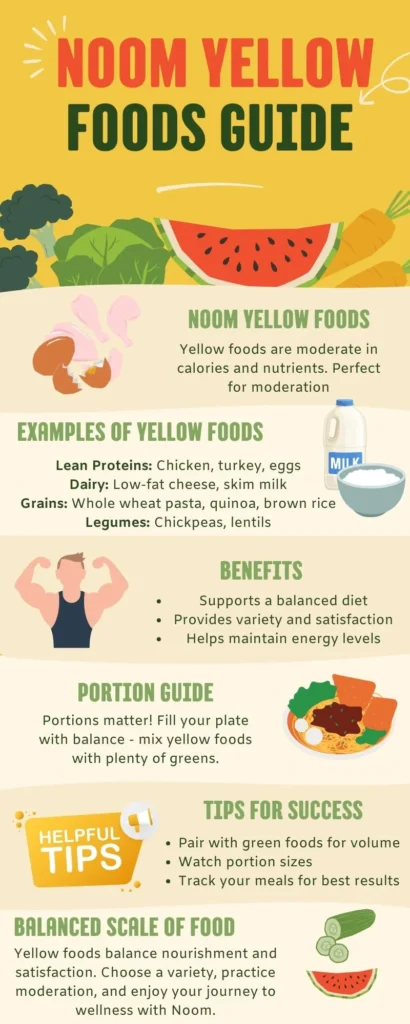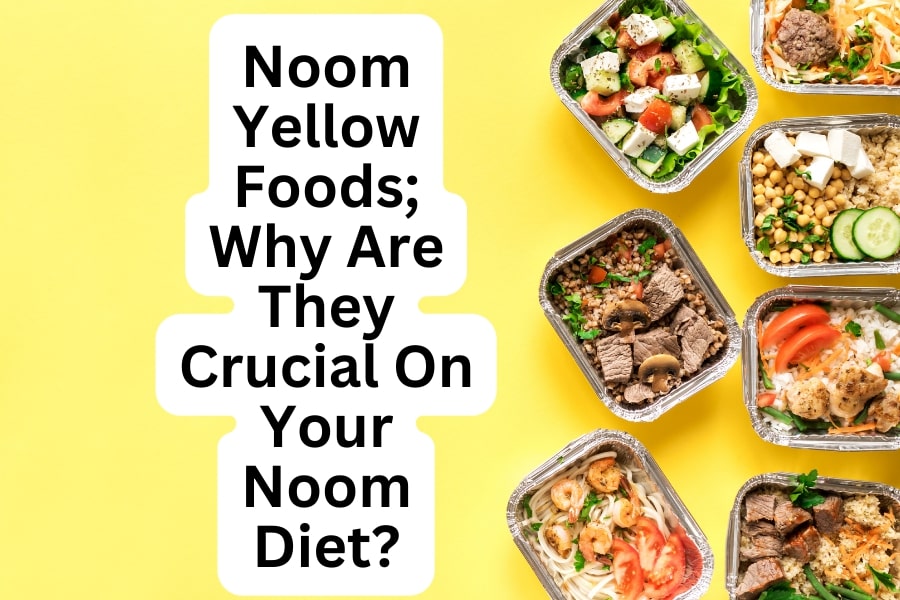Have you ever heard about Noom Yellow Foods? Yes, the Noom diet classified foods in a color-coded system.
In recent years, Noom has sparked varied opinions among users and wellness experts alike. While some argue that its services might contribute to a problematic relationship with food, others, including our own nutritionist, recognize Noom’s efforts to promote sustainable and wholesome eating habits. The brand, often dubbing its followers “Noomers,” offers more than just a dieting plan. Its comprehensive system encompasses both Noom Weight and Noom Mood, with a focus on nutrition education and mental health well-being.
Noom’s color-coded system simplifies nutrition, categorizing foods into green, yellow, and orange groups for intuitive calorie control without strict diets. It puts long-term lifestyle changes ahead of quick weight loss, according to psychologists.
Personalized coaching connects users and coaches, offering tailored guidance during business hours. Beyond weight, the app tracks broader health metrics like blood pressure and glucose, promoting comprehensive well-being insights. Noom’s holistic approach resonates with sustainable, balanced health transformations
But the question remains: How does Noom promote weight loss without imposing strict ingredient restrictions? The answer lies in the adaptable nature of its color-coded system. Coaches and personal health assessments shape the system to suit each user’s unique requirements, creating a flexible yet structured path towards healthier living.
In this article, we will focus especially on Noom yellow foods. We will answer various questions, like, What are the yellow foods? What is included in the Noom yellow foods list, and others, so continue reading.
What are yellow foods?
In the Noom diet, the classification of foods as “yellow” is based on a strategic approach that considers their nutritional composition and impact on overall health.
The classification of foods into different categories, including “green,” “yellow,” and “orange,” is meant to provide a simple and intuitive way for individuals to make informed food choices. “Yellow” foods, in particular, occupy a middle ground between the more liberally labeled “green” foods and the more cautiously labeled “orange” foods. This distinction reflects the nutritional density, calorie content, and potential effects on weight management and overall health.
“Yellow” foods are selected based on their moderate nutritional values. They are neither as calorie-dense as “orange” foods nor as low-calorie as “green” foods. Instead, they strike a balance between providing essential nutrients and ensuring that caloric intake remains reasonable. This approach encourages individuals to include a variety of foods in their diet while maintaining a level of awareness regarding portions and overall energy consumption.
Remember, the value of categorizing foods lies in its ability to provide structure and guidance, helping individuals make conscious choices while enjoying a balanced approach to nutrition.
Check out our latest posts;
- Breatharianism Diet; Is Breatharian a Real Thing
- Ectomorph Diet to Gain Weight and Muscles; 101 Guide
- Ectomorph, Endomorph, Mesomorph; Uncover The Secret Of Each
- The #1 Thing People Get Wrong About Endomorph Diet Plan Female
- Ecto-Mesomorph; Discover Their Unique Body Traits
- Noom Versus Weight Watchers; Pros, Cons, & Reviews

What is on the Noom yellow foods list?
By understanding why certain foods are classified as “yellow,” individuals can make choices that suit their dietary preferences, health goals, and lifestyle. It’s important to approach “yellow” foods not as items to avoid, but as foods to enjoy in moderation.
Lean Protein:
- Steak
- Fish
- Turkey
- Chicken breast
- Lamb
- Canned tuna
- Sushi
Fruits:
- Olives
- Dried apricots
- Prunes
- Canned pineapples
- Avocado
- Plantain
Dairy:
- Low-fat yogurt
- 2% low-fat milk
- Low-fat cottage cheese
- Low-fat cheese
Snacks:
- Hummus
- Fruit cup
- Banana pancake
- Rice pudding
- Acai bowl
Beverages:
- Diet sodas
- Ginger tea
- Grapefruit juice
- Orange juice
- Fruit smoothie
- Unsweetened cranberry juice
Legumes:
- Lentils
- Edamame
- Baked and refried beans
- Tempeh
- Chickpeas
Condiments:
- Gravy
- Oyster sauce
- Cacao powder
- Balsamic vinegar
- Mustard
- Soy sauce
- Pizza sauce
Related;
- Fasting Mimicking Diet Food List; 5 Food to Eat, & Drawbacks
- Sirtfood Diet; Food List, Meal Plan, & Reviews
- Dr. Perricone Diet 28-Day: Plan, Shopping List, & Phases
- Alkaline Vegan Diet by Dr. Sebi: Food list, Pros & Cons
Why is Coca Cola yellow on Noom?
On Noom, Coca-Cola is labeled “yellow” due to its calorie and nutritional makeup.
Foods and drinks are grouped according to their nutritional value and calorie density in Noom’s color-coded system. “Yellow” foods are often fairly calorie-dense since they fall in the middle of the calorie density spectrum.
Coca-Cola has calories, but the beverage’s high sugar content partially offsets those calories. This puts it in the “yellow” category because it has more calories than foods in the “green” category (which have less calories), but fewer calories than other foods in the “orange” category (which are normally higher in calories).
It’s vital to remember that Noom’s color-coded approach promotes balanced and attentive eating in addition to calorie content. While a food or drink may be classified as “yellow” based on its calorie count, Noom advises users to also take into account other aspects of their options, such as nutritional value and the overall effects on their health.
Coca-Cola or other comparable beverages should be used in moderation, just like any other meal or drink, taking into account how they will affect your entire diet and health objectives. It’s a good idea to review their official standards or speak with their support staff if you have specific inquiries regarding how Noom categorizes particular foods or beverages.
Related; Diet Coke With Splenda: Available or Not?
What are the best Noom yellow foods snacks?
Noom’s selection of “yellow” foods for snacks offers a diverse range of options that strike a balance between satisfying cravings and supporting balanced nutrition. These “yellow” snacks are chosen for their moderate caloric content and nutrient density, making them an ideal choice for those seeking a mindful approach to snacking.
- Hummus: Creamy and versatile dip made from chickpeas, perfect for pairing with veggies or whole-grain crackers.
- Fruit Cup: A refreshing mix of various fruits, offering natural sweetness and a variety of vitamins and minerals.
- Banana Pancake: A nutritious twist on a classic favorite, made with ripe bananas and whole-grain ingredients.
- Rice Pudding: A comforting and satisfying option, combining rice with low-fat dairy for a touch of sweetness.
- Acai Bowl: Packed with antioxidants, this vibrant bowl features acai berries, fruits, and toppings like granola or nuts.
These “yellow” snack choices provide a blend of flavors and textures while aligning with Noom’s emphasis on balanced nutrition and portion awareness.
Related;
- Top 10 Zero Calorie Snacks That Won’t Ruin Your Diet
- 9 Vegetarian Late Night Snacks
- What Are The Best AIP Snacks Whole Foods?
- 9 Ideas for Bedtime Snack to Lower Blood Sugar in the Morning
- Nutrisystem Meals and Snacks Review
Conclusion
The universe of Noom Yellow Foods, in conclusion, reveals a dynamic and well curated spectrum of options that go beyond the limitations of conventional dieting. By adopting the color-coded system, people start down a path that promotes mindful eating and a positive relationship with food.
Foods are strategically categorized as “yellow” to celebrate their modest nutritional content and to introduce a wide variety of flavors into our daily life. The focus is shifted from quick weight loss to comprehensive transformation in Noom’s method, which promotes sustainable well-being.

A fascinating discussion is worth comment. I do believe that you need to write more
about this subject matter, it may not be a taboo subject but typically people do not discuss these issues.
To the next! Cheers!!